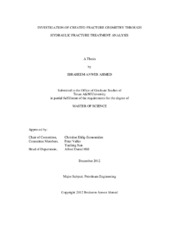| dc.contributor.advisor | Ehlig-Economides, Christine A | |
| dc.creator | Ahmed, Ibraheem 1987- | |
| dc.date.accessioned | 2013-03-14T16:17:58Z | |
| dc.date.available | 2014-12-12T07:18:55Z | |
| dc.date.created | 2012-12 | |
| dc.date.issued | 2012-11-30 | |
| dc.date.submitted | December 2012 | |
| dc.identifier.uri | https://hdl.handle.net/1969.1/148246 | |
| dc.description.abstract | Successful development of shale gas reservoirs is highly dependent on hydraulic fracture treatments. Many questions remain in regards to the geometry of the created fractures. Production data analysis from some shale gas wells quantifies a much smaller stimulated pore volume than what would be expected from microseismic evidence and reports of fracturing fluids reaching distant wells. In addition, claims that hydraulic fracturing may open or reopen a network of natural fractures is of particular interest.
This study examines hydraulic fracturing of shale gas formations with specific interest in fracture geometry. Several field cases are analyzed using microseismic analysis as well as net pressure analysis of the fracture treatment. Fracture half lengths implied by microseismic events for some of the stages are several thousand feet in length. The resulting dimensions from microseismic analysis are used for calibration of the treatment model. The fracture profile showing created and propped fracture geometry illustrates that it is not possible to reach the full fracture geometry implied by microseismic given the finite amount of fluid and proppant that was pumped. The model does show however that the created geometry appears to be much larger than half the well spacing. From a productivity standpoint, the fracture will not drain a volume more than that contained in half of the well spacing. This suggests that for the case of closely spaced wells, the treatment size should be reduced to a maximum of half the well spacing.
This study will provide a framework for understanding hydraulic fracture treatments in shale formations. In addition, the results from this study can be used to optimize hydraulic fracture treatment design. Excessively large treatments may represent a less than optimal approach for developing these resources. | en |
| dc.format.mimetype | application/pdf | |
| dc.subject | Microseismic Analysis | en |
| dc.subject | Shale Gas | en |
| dc.subject | Hydraulic Fracturing | en |
| dc.title | Investigation of Created Fracture Geometry through Hydraulic Fracture Treatment Analysis | en |
| dc.type | Thesis | en |
| thesis.degree.department | Petroleum Engineering | en |
| thesis.degree.discipline | Petroleum Engineering | en |
| thesis.degree.grantor | Texas A&M University | en |
| thesis.degree.name | Master of Science | en |
| thesis.degree.level | Masters | en |
| dc.contributor.committeeMember | Valko, Peter | |
| dc.contributor.committeeMember | Sun, Yuefeng | |
| dc.type.material | text | en |
| dc.date.updated | 2013-03-14T16:17:58Z | |
| local.embargo.terms | 2014-12-01 | |


